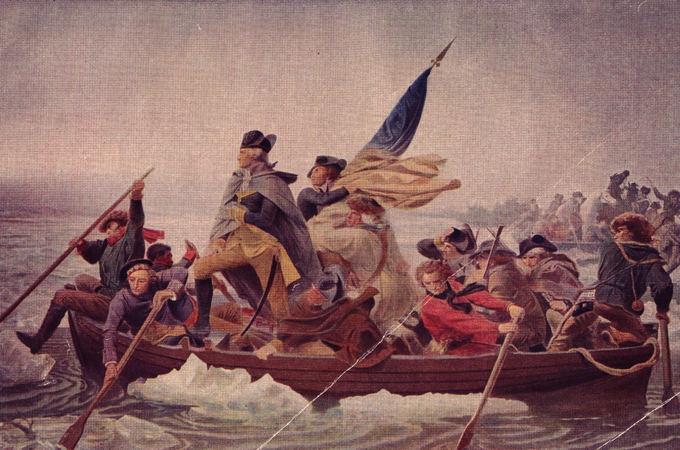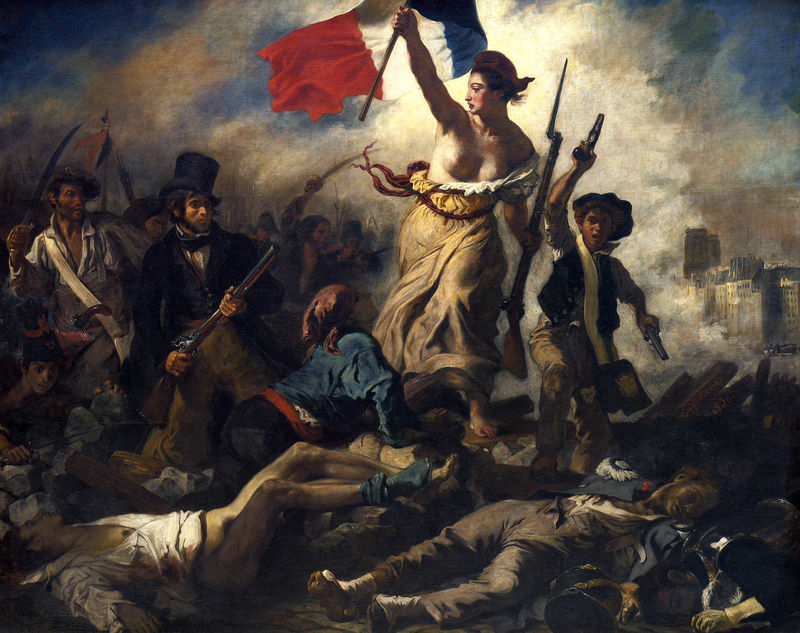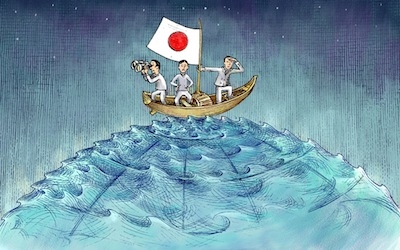
Nationalism is defined by the Encyclopaedia
Britannica as an "ideology based on the premise that the individual's loyalty and devotion to the nation-state surpass other individual or group interests." During the 18th century, the concept of the nation-state (as defined by the UN, a place where "the great majority are conscious of a common identity and share the same culture), took hold, giving rise to a wave of Nationalism worldwide, but especially in Europe. Nationalism created the face of the geopolitics we know today, and it continues to change and influence the way we as humans understand our identities and place in our nations, and the wider world.
 The first large-scale demonstration of the desire for an independent national identity was the American Revolution, in which the 13 North American colonies fought for separation and independence from Great Britain. Newly untied under a common Constitution, the young American state set a precedent for additional Nationalist revolutions. In a speech in 1858, President Abraham Lincoln attributed the US's national unity to the Declaration of Independence, heralding it as a cornerstone for uniting peoples of different ancestry under the American identity. Thus, even though the peoples populating American didn't share an ethnic identity, common ideology and a desire for homogeneous culture (leading to the impression of America as a "melting pot") led to a strong Nationalist identity. *A 21st-century revival of Nationalism in America is often expressed as hatred directed towards immigrants in a desire to keep the country "American".
The first large-scale demonstration of the desire for an independent national identity was the American Revolution, in which the 13 North American colonies fought for separation and independence from Great Britain. Newly untied under a common Constitution, the young American state set a precedent for additional Nationalist revolutions. In a speech in 1858, President Abraham Lincoln attributed the US's national unity to the Declaration of Independence, heralding it as a cornerstone for uniting peoples of different ancestry under the American identity. Thus, even though the peoples populating American didn't share an ethnic identity, common ideology and a desire for homogeneous culture (leading to the impression of America as a "melting pot") led to a strong Nationalist identity. *A 21st-century revival of Nationalism in America is often expressed as hatred directed towards immigrants in a desire to keep the country "American". Though French Nationalism is said to have began with Joan of Arc, 19th century Nationalism found manifestation in Napoleon Bonaparte's expansion across Europe, combining Nationalism with Imperialism. France believed that, as an enlightened nation after their revolution, they had the right to share their knowledge with the rest of Europe by conquering them. The French motto, "Liberty, Equality, Fraternity" was also produced during the French revolution; like the Declaration of Independence, it provided a landmark for values deemed distinctly French.
Though French Nationalism is said to have began with Joan of Arc, 19th century Nationalism found manifestation in Napoleon Bonaparte's expansion across Europe, combining Nationalism with Imperialism. France believed that, as an enlightened nation after their revolution, they had the right to share their knowledge with the rest of Europe by conquering them. The French motto, "Liberty, Equality, Fraternity" was also produced during the French revolution; like the Declaration of Independence, it provided a landmark for values deemed distinctly French. As in the American Revolution, many Nationalist movements were centered around various ethnic groups attempting to gain independence from empires or colonizers. The Ottoman Empire, by this time considered the "sick man of Europe," was further weakened by a number of Nationalist revolts within its borders. Albanians, Arabs, Armenians, Bosniaks, Bulgarians, Greeks, Kurds, Jews, Macedonians, Romanians, Serbs, and Turks all sought after their own separate nation-states. Arab Nationalism, very prominent in the region, was largely a backlash to the Turkish Nationalism occurring simultaneously. The Young Turks were one such Turkish National group that gained a good deal of power within the empire. Some of these groups achieved independence, but at a steep price. The Armenian Genocide was a horrific massacre of the Armenian people at the hands of the Ottomans; though the Armenians had always been discriminated against in the empire, the rise of Armenian Nationalism and their desire for more rights in the empire was repressed brutally. Some groups, like the Kurds, are still fighting for their own national identity.
As in the American Revolution, many Nationalist movements were centered around various ethnic groups attempting to gain independence from empires or colonizers. The Ottoman Empire, by this time considered the "sick man of Europe," was further weakened by a number of Nationalist revolts within its borders. Albanians, Arabs, Armenians, Bosniaks, Bulgarians, Greeks, Kurds, Jews, Macedonians, Romanians, Serbs, and Turks all sought after their own separate nation-states. Arab Nationalism, very prominent in the region, was largely a backlash to the Turkish Nationalism occurring simultaneously. The Young Turks were one such Turkish National group that gained a good deal of power within the empire. Some of these groups achieved independence, but at a steep price. The Armenian Genocide was a horrific massacre of the Armenian people at the hands of the Ottomans; though the Armenians had always been discriminated against in the empire, the rise of Armenian Nationalism and their desire for more rights in the empire was repressed brutally. Some groups, like the Kurds, are still fighting for their own national identity. The Greeks set an example for the rest of the peoples governed by the Ottoman Empire. Thanks to the Treaty of Constantinople, the Greeks became the first peoples of the Ottoman Empire to achieve the status of an independent sovereign power. While the Greeks had maintained a cultural identity under Ottoman rule, largely tied to their sense of Hellenism fostered by the Greek Orthodox Church, they were still a subject peoples deprived of political rights. When the wave of Nationalism washed over Europe, they too were caught up in it, and they received support from several Western European nations and their own Greek merchant diaspora. Russia, France, and the United Kingdom backed Greece, hailing the value of independence, and also largely aiming to defeat a major Islamic power - the Ottoman Empire - and support a budding Christian nation.
The Greeks set an example for the rest of the peoples governed by the Ottoman Empire. Thanks to the Treaty of Constantinople, the Greeks became the first peoples of the Ottoman Empire to achieve the status of an independent sovereign power. While the Greeks had maintained a cultural identity under Ottoman rule, largely tied to their sense of Hellenism fostered by the Greek Orthodox Church, they were still a subject peoples deprived of political rights. When the wave of Nationalism washed over Europe, they too were caught up in it, and they received support from several Western European nations and their own Greek merchant diaspora. Russia, France, and the United Kingdom backed Greece, hailing the value of independence, and also largely aiming to defeat a major Islamic power - the Ottoman Empire - and support a budding Christian nation. Like the Ottoman Empire, the Habsburg Empire encompassed a vast number of ethnic groups who expressed their nationalist spirit in a series of revolutions occurring between March 1848 to November 1849. The Austrian Empire ruled Germans, Hungarians, Slovenes, Poles, Czechs, Slovaks, Ukrainians, Romanians, Croats, Italians, and Serbs from its seat of power in Vienna. The Revolutions of 1848 culminated in the Hungarian Revolution of 1848, in which the Kingdom of Hungary fought for independence and sovereignty away from the rule of Habsburg Austria. Under Habsburg rule, Hungary was allowed to maintain its own parliament, the Hungarian Diet. Desiring further autonomy, the Hungarians began their revolution, which eventually turned into a war for independence. The Habsburgs, at the brink of collapse, called upon the Russians for help in suppressing the Hungarians; after the failed Hungarian revolt, they were placed under intense scrutiny and heavy military supervision. Later, the Hungarians successfully achieved autonomy.
Like the Ottoman Empire, the Habsburg Empire encompassed a vast number of ethnic groups who expressed their nationalist spirit in a series of revolutions occurring between March 1848 to November 1849. The Austrian Empire ruled Germans, Hungarians, Slovenes, Poles, Czechs, Slovaks, Ukrainians, Romanians, Croats, Italians, and Serbs from its seat of power in Vienna. The Revolutions of 1848 culminated in the Hungarian Revolution of 1848, in which the Kingdom of Hungary fought for independence and sovereignty away from the rule of Habsburg Austria. Under Habsburg rule, Hungary was allowed to maintain its own parliament, the Hungarian Diet. Desiring further autonomy, the Hungarians began their revolution, which eventually turned into a war for independence. The Habsburgs, at the brink of collapse, called upon the Russians for help in suppressing the Hungarians; after the failed Hungarian revolt, they were placed under intense scrutiny and heavy military supervision. Later, the Hungarians successfully achieved autonomy.![Herzl, Theodor [Credit: Photos.com/Jupiterimages]](http://media-2.web.britannica.com/eb-media/13/316x450x133613-004-A894D784.jpg.pagespeed.ic.CZ7Sg-FOYi.webp) With the rise of Nationalism in Europe came a renewed spirit of equality for all citizens, regardless of religion. But when Jews were granted full political rights and began thriving in up-and-coming fields traditionally considered "Christian," (i.e. banking, politics, law, and the arts), a renew wave of antisemitism arose in Europe. Since Jews had so long been in hidden professions, their emergence into the public sphere was viewed as "overtaking" Christian jobs and opportunities. With an huge increase in pogroms and other violence, Zionism emerged - a Jewish Nationalist movement aiming to create a state in the homeland in Palestine. Theodore Herzl (left) is largely credited as the father of Zionism. He believed that assimilation in European nations was desirable, but quite obviously improbable due to the violence Jews faced. The Ottoman Empire, which ruled over Palestine at the time, refused to sell it to the Jews, who instead found political support from Great Britain. They were offered Uganda, but held out for Palestine, their Holy Land and ancient homeland. With increased violence after the Russian Revolution, Jews began emigrating to Palestine to settle in growing farming communities. With the growing Jewish population came a new Jewish national identity; Modern Hebrew became widely used, Hebrew education and Jewish arts took root, and a uniquely regional Judaism focused on hard work and the land emerged.
With the rise of Nationalism in Europe came a renewed spirit of equality for all citizens, regardless of religion. But when Jews were granted full political rights and began thriving in up-and-coming fields traditionally considered "Christian," (i.e. banking, politics, law, and the arts), a renew wave of antisemitism arose in Europe. Since Jews had so long been in hidden professions, their emergence into the public sphere was viewed as "overtaking" Christian jobs and opportunities. With an huge increase in pogroms and other violence, Zionism emerged - a Jewish Nationalist movement aiming to create a state in the homeland in Palestine. Theodore Herzl (left) is largely credited as the father of Zionism. He believed that assimilation in European nations was desirable, but quite obviously improbable due to the violence Jews faced. The Ottoman Empire, which ruled over Palestine at the time, refused to sell it to the Jews, who instead found political support from Great Britain. They were offered Uganda, but held out for Palestine, their Holy Land and ancient homeland. With increased violence after the Russian Revolution, Jews began emigrating to Palestine to settle in growing farming communities. With the growing Jewish population came a new Jewish national identity; Modern Hebrew became widely used, Hebrew education and Jewish arts took root, and a uniquely regional Judaism focused on hard work and the land emerged. As shown through the Zionist movement in Palestine and Ottoman Nationalism, Nationalism was not a solely Western phenomenon. In the Far East, Japan was the nation to experience the largest Nationalist movement. Starting with Mathew Perry's demands for an open Japan and the threat of encroaching foreigners, the Japanese saw the benefits of creating a strong central authority that would allow them to compete with the Great Western powers. The Meiji Restoration brought about such an opportunity. After being forced to submit to several unequal treaties with Europe, just as China had been, Japan completely restructured its government, combining traditional Japanese culture with Western politics. This enabled them to industrialize - the first non-Western nation to do so - and to create a military that could hold its own against the West, as it certainly did in the Russo-Japanese War. Japanese Nationalism, like that of many other nations, expressed itself in the forms of Imperialism, military power, and a strong loyalty to the ruler (in their case, the emperor). It was the adoption of such strong Nationalism that saved Japan from a fate like China's - exploited and undermined by the West - and instead helped make it a Great Power in the late-19th and 20th centuries.
As shown through the Zionist movement in Palestine and Ottoman Nationalism, Nationalism was not a solely Western phenomenon. In the Far East, Japan was the nation to experience the largest Nationalist movement. Starting with Mathew Perry's demands for an open Japan and the threat of encroaching foreigners, the Japanese saw the benefits of creating a strong central authority that would allow them to compete with the Great Western powers. The Meiji Restoration brought about such an opportunity. After being forced to submit to several unequal treaties with Europe, just as China had been, Japan completely restructured its government, combining traditional Japanese culture with Western politics. This enabled them to industrialize - the first non-Western nation to do so - and to create a military that could hold its own against the West, as it certainly did in the Russo-Japanese War. Japanese Nationalism, like that of many other nations, expressed itself in the forms of Imperialism, military power, and a strong loyalty to the ruler (in their case, the emperor). It was the adoption of such strong Nationalism that saved Japan from a fate like China's - exploited and undermined by the West - and instead helped make it a Great Power in the late-19th and 20th centuries. Across the Atlantic, South America was trying to repair the damage from European Imperialism. Many nations experienced a surge of Nationalism following their liberation or independence - Argentina's, for example, was strengthened after their War for Independence in the early 19th century. Others fueled their Nationalism with a hate for their colonizing oppressors; in Brazil, anti-Portuguese sentiments ran so high that French was spoken in order to disparage the Portuguese people and their culture. Others still bolstered their Nationalism by drawing upon their rich cultural past. In Peru, the ethnic identities of the Quechua and the Inca were called upon to unite people. In similarity with many of the Great Powers of the time, Peru also found a more militaristic outlet for its Nationalism - wars and border disputes with its neighbor, Ecuador.
Across the Atlantic, South America was trying to repair the damage from European Imperialism. Many nations experienced a surge of Nationalism following their liberation or independence - Argentina's, for example, was strengthened after their War for Independence in the early 19th century. Others fueled their Nationalism with a hate for their colonizing oppressors; in Brazil, anti-Portuguese sentiments ran so high that French was spoken in order to disparage the Portuguese people and their culture. Others still bolstered their Nationalism by drawing upon their rich cultural past. In Peru, the ethnic identities of the Quechua and the Inca were called upon to unite people. In similarity with many of the Great Powers of the time, Peru also found a more militaristic outlet for its Nationalism - wars and border disputes with its neighbor, Ecuador.
For the entirety of this blog post, Africa has been neglected. Thanks to the European's long-lasting colonization of the entire African continent, the African Nationalist movements came later, in the mid-20th century. At right is the Pan-African flag; Pan-Africanism seeks to unite the continent, and encourages solidarity between nations. Created in the early 20th century, it is still popular today. Because of its being more recently liberated (Ghana, in 1957 was the first African country to achieve independence), the geopolitics of Africa are still changing. In 2011, South Sudan seceded from Sudan in order to achieve sovereignty. The vast cultural diversity and lack of long-term unification of African peoples has led to borders being drawn in peculiar places, lumping together fierce rivals, like the Hutus and Tutsis in Rwanda. The impact of European colonization on Africa has been tremendous and devastating, and they are still in the midst of recovering.
Sources
1. http://www.theimaginativeconservative.org/wp-content/uploads/2014/10/b.png
2. http://www.aljazeera.com/mritems/Images/2011/3/7/20113714026398876_20.jpg
3. http://www.artble.com/imgs/b/d/4/134968/july_28_liberty_leading_the_people.jpg
4. http://i.imgur.com/zb7gJ.jpg
5. https://xaameriki.files.wordpress.com/2012/10/greek.jpg
6. https://upload.wikimedia.org/wikipedia/commons/8/8e/Growth_of_Habsburg_territories.jpg
7. http://www.britannica.com/topic/Zionism
8. http://www.hoover.org/sites/default/files/uploads/inline/images/large/alonefinal244.jpg
9. http://thumbnails-visually.netdna-ssl.com/south-american-flag-map_502914f0c1ea2_w1500.png
10. https://en.wikipedia.org/wiki/Pan-Africanism
No comments:
Post a Comment